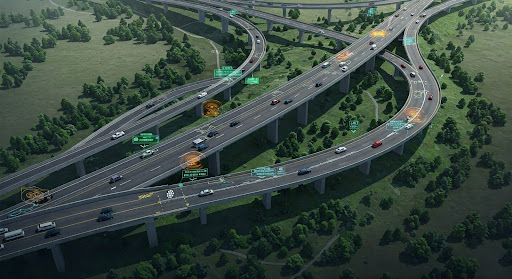
With over 4.2 million miles of public roads and 47,000 miles of interstate highways, the United States maintains one of the most expansive roadway networks in the world. This vast infrastructure system is critical to both the economy and public safety, supporting more than 230 million licensed drivers and facilitating trillions in annual freight movement. Yet, despite consistent investment, safety remains an urgent challenge. In 2021, over 42,900 people lost their lives in traffic incidents, the highest figure in more than a decade.
Maintaining and improving these systems requires far more than pouring concrete. It calls for engineers who can plan for population growth, new technologies, and changing climates, while also solving the everyday challenges of mobility and safety. Engineers like Kamlesh Khatri.
A licensed Professional Engineer by the age of 25 and now a project leader on several multimillion-dollar highway programs, Kamlesh represents a new generation of civil engineers who are not only solving current infrastructure needs but also anticipating tomorrow’s demands. “The future of transportation is all about balance, balancing safety with efficiency, sustainability with growth,” Kamlesh says. “Every road I design is a piece of the larger puzzle, connecting people, ideas, and opportunities for generations to come.”
A Career Built on Precision and Public Safety
Kamlesh’s path began with a master’s degree in civil engineering from the University of Texas at Arlington, where he worked as a research assistant on a project funded by the Florida Department of Transportation and the American Concrete Pipe Association. That project, focused on developing 100-year service life protocols for synthetic fiber-reinforced concrete pipes, was Kamlesh’s entry into materials innovation and long-term infrastructure resilience.
Since then, Kamlesh has become known for applying that same forward-thinking approach to large-scale roadway systems. After his early work at RPS North America, he joined Teague Nall & Perkins in 2022, where he led design for the Ferguson Parkway in Anna, Texas, a new connector roadway planned to alleviate congestion and improve regional access.
The project’s complexity went far beyond the surface. It involved not only designing a new bridge over Slayter Creek to support both vehicular traffic and a bike trail, but also fixing a serious safety issue: a visibility problem at the planned intersection with the Collin County Outer Loop.
“We had to completely rework the alignment to eliminate the blind spot,” Kamlesh explains. “Poor sight distance at intersections can lead to severe accidents. It wasn’t enough to meet minimum standards, we wanted to exceed them.” The redesign, applauded by the city’s engineering department, turned what could have been a hazard into a model for safe urban expansion.
Leading Projects That Serve Millions
At Woolpert, Kamlesh served as Project Engineer for the firm’s South Region Transportation Team. He led design on two high-value transportation corridors:
- FM 517 (SH35 to FM 646) – A $140 million TxDOT initiative to improve coastal access and flood resilience through redesign of drainage and pavement systems.
- IH10 (FM 359 to West of Snake Creek) – An $850 million expansion aimed at increasing capacity and safety across a heavily traveled section of interstate.
But Kamlesh’s most notable contribution to date may be the SH176 E corridor project, a $1.3 billion redesign that connected energy and freight sectors in West Texas to broader national markets. The corridor currently serves tens of thousands of daily commuters and commercial vehicles.
“Our modeling suggested that the completed project would reduce congestion by up to 35% and cut accident rates by nearly 20% over five years,” Kamlesh says. “That kind of impact isn’t just technical, it affects people’s lives, daily routines, and the region’s economy.”
Building Smarter, Safer Roads, For the Long Term
Kamlesh’s engineering philosophy blends problem-solving with long-term thinking. He is TxDOT-precertified in six technical categories, including schematic design, land planning, and signing/pavement channelization, areas that require both deep technical skill and an understanding of how roadways interact with community behavior and traffic trends.
Yet he’s quick to point out that good engineering doesn’t happen in isolation. “You have to understand not just the materials and codes, but also the context, where people live, how they move, and how transportation systems can either connect or divide communities.”
His involvement extends beyond the design table. Kamlesh serves as Director of the ASCE Fort Worth Branch, chairs the branch’s scholarship committee, and regularly mentors aspiring engineers through technical presentations, including “Becoming a Texas PE: A Comprehensive Guide from Student to Licensed Engineer.”
As a technical reviewer for both the ASCE Journal of Transportation Engineering and the UK-based Institution of Civil Engineers, he evaluates cutting-edge transportation research from around the world. “It keeps me informed and accountable,” Kamlesh says. “If we want safer, smarter infrastructure, it has to start with quality thinking.”
Innovating for an Uncertain Future
The profession, Kamlesh notes, is evolving quickly. With electric vehicles, autonomous driving, and climate resilience all shaping design decisions, modern engineers are expected to build not only for present traffic volumes, but also for changing technologies and weather patterns.
“Think about how roads will need to support EV charging infrastructure,” he says. “Or how intersections will need to accommodate both human and machine drivers. We’re not just building roads, we’re building for scenarios we haven’t fully seen yet.”
That ethos has informed Kamlesh’s work with advanced materials too. During his early research years, he worked on synthetic fiber-reinforced concrete, a material that extends roadway life and reduces maintenance frequency, meaning fewer construction disruptions, lower emissions, and better cost-efficiency. “It’s the small decisions, made early, that have the biggest long-term impact,” he reflects.
Designing with Purpose
Whether solving a sight distance problem on a local road or managing a billion-dollar interstate project, Kamlesh sees his role as deeply connected to public well-being.
“Roads aren’t just asphalt and paint, they’re how people get to work, visit family, go to school. If they’re not safe, efficient, or inclusive, they fail in their basic purpose,” he says. “I try to keep that in mind every time I start a new design.”
Through his thoughtful, data-driven approach to transportation engineering, Kamlesh Khatri exemplifies how technical expertise can serve broader societal goals. He doesn’t just build infrastructure, he builds systems that connect communities, reduce risks, and prepare the country for what comes next.
As the U.S. continues to modernize and expand its roads, professionals like Kamlesh remind us that safety and sustainability are not afterthoughts, they are the foundation.



